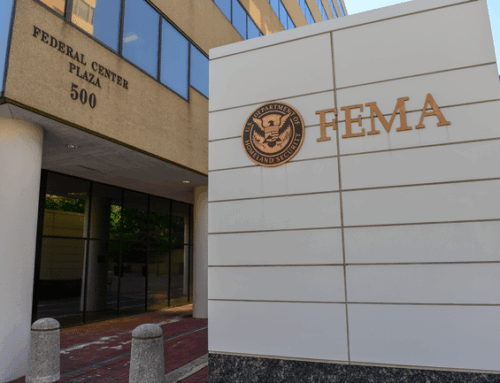On Wednesday, March 1, the Senate Committee on the Budget held its second hearing of the 118th Congress: “Rising Seas, Rising Costs: Climate Change and the Economic Risks to Coastal Communities.” Hearing witnesses included Dr. Sean Becketti, Principal at Elliott Bay Analytics; Mr. Matthew Eby, Founder and Chief Executive Officer of First Street Foundation; Dr. Marlo Lewis, Jr., Senior Fellow at Competitive Enterprise Institute; Ms. Kate Michaud, Town Manager of Warren, Rhode Island; and Dr. Jessica Weinkle, Associate Professor of University of North Carolina Wilmington.
This hearing was the second in a series that will examine climate change’s budgetary costs. While the first hearing, held two weeks earlier, was “a high-level budget impact overview,” Chairman Whitehouse (D-RI) said the next hearings will dive into the specific ways climate change has and will continue to burden the economy and federal budget – including in coastal communities.
Increasingly frequent and deadly hurricanes and rising sea levels pose immediate risks to coastal infrastructure and communities. According to the November 2018 National Climate Assessment report, the “continued increase in the frequency and extent of high-tide flooding due to sea level rise threatens America’s trillion-dollar coastal property market and public infrastructure, with cascading impacts on the larger economy.”
Ms. Kate Michaud, Town Manager of Warren, Rhode Island, exemplified these concerns in her testimony, describing how rising sea levels have and will continue to impact her town’s infrastructure negatively, costing taxpayers millions of dollars. According to Ms. Michaud, a recent analysis determined that if no action were taken against rising sea levels, the town of Warren would suffer more than $137 million in property damage by 2100.
Sen. Patty Murray (D-WA) and Sen. Alex Padilla (D-CA) echoed this estimate with stories of their own home states. Sen. Murray said that she has also seen how “rising sea levels, increased flooding, and storm surge risk does real damage to our working waterfront, to our community infrastructure, to our housing supply, and the coastal ecosystem that support our fisheries.” Sen. Alex Padilla (D-CA) cited a recent study that found that more than 400 facilities in with hazardous materials in California – including power plants, refineries, industrial facilities, and hazardous waste sites – will experience flooding events by the end of the century.
It is important to note that the effects of sea level rise and increasing coastal natural disasters will not be felt universally and instead will disproportionately affect poor and disadvantaged communities and people of color. Research from the First Street Foundation, cited by Mr. Matthew Eby, found that the home value at risk of flooding in formerly redlined districts was $170 million, double the home value at risk in other districts. Mr. Eby also noted that not only are low-to-moderate income (LMI) households “much more at risk and much more exposed,” but they are also less likely to be insured.
Rising sea levels also affect defense infrastructure. Sen. Kaine (D-VA) cited the Virginia Coastal Resilience Master Plan, which estimates that 31,000 acres of DoD facilities in Virginia will have at least a 1% annual chance of shallow flooding in 2080. Climate change is a national security issue. Worldwide, a three-foot sea level rise could threaten as many as 128 U.S. military bases worldwide, valued at roughly $100 billion, according to the Union of Concerned Scientists. And recent flooding and hurricanes have previewed the future damages and costs that taxpayers may face from Defense installations standing in harm’s way. For example, Hurricane Florence caused $3.6 billion in damage to Marine Corps facilities in North Carolina.
Not all witnesses, including Dr. Jessica Weinkle and Dr. Marlo Lewis, or committee members agreed that increasing coastal flooding was driven by climate change. However, there was generally bipartisan agreement on the need to increase community resilience to flooding and other extreme weather events. Dr. Weinkle said that “reducing coastal risk makes good sense” and Dr. Lewis highlighted “the marvelous power of adaptation” in his testimony. Sen. Ron Johnson (R-WI), albeit in speaking against spending to address climate change, said that “we’re far better off spending resources adapting.”
Policymakers need to make smart, common-sense investments in creating more resilience communities. The costs of climate change are already felt by American taxpayers today and are only going to grow. And every $1 spent on mitigation can save $6 or more in post-disaster response. As Mr. Eby said in the hearing, “it’s much more expensive to try and do these things retroactively than to actually manage these things from the beginning.”
One resource praised by Ms. Michaud was the Building Resilient Infrastructure Communities (BRIC) Program, implemented by the Federal Emergency Management Agency (FEMA). Through BRIC, communities can receive federal dollars to reduce their risk to future natural disasters. Prevention programs like this have the opportunity to create more resilient communities while also saving taxpayers money.
Policymakers also need to avoid policies that incentivize risky behaviors that create future liabilities for taxpayers. In his opening statement, Dr. Sean Becketti, Principal at Elliott Bay Analytics, addressed concerns with how the National Flood Insurance Program (NFIP) encourages development in the floodplain and, ultimately, costs taxpayers. The NFIP is primary source of flood insurance in the United States, with more than five million policyholders across 23,000 communities. Through subsidized insurance premiums and outdated floodplain maps, NFIP has made it economically “safe” to build in medium-and high-risk areas at the taxpayers’ expense. According to Dr. Becketti, NFIP accrues “over a million dollars per day in interest charges on its approximately $20 billion in debt.” TCS has long called for reform to the National Flood Insurance Program, testifying to the House and Senate on multiple occasions. And while FEMA’s new Risk Rating 2.0 has worked to reduce some of the cross-subsidies that have plagued the program, more work remains to be done.









